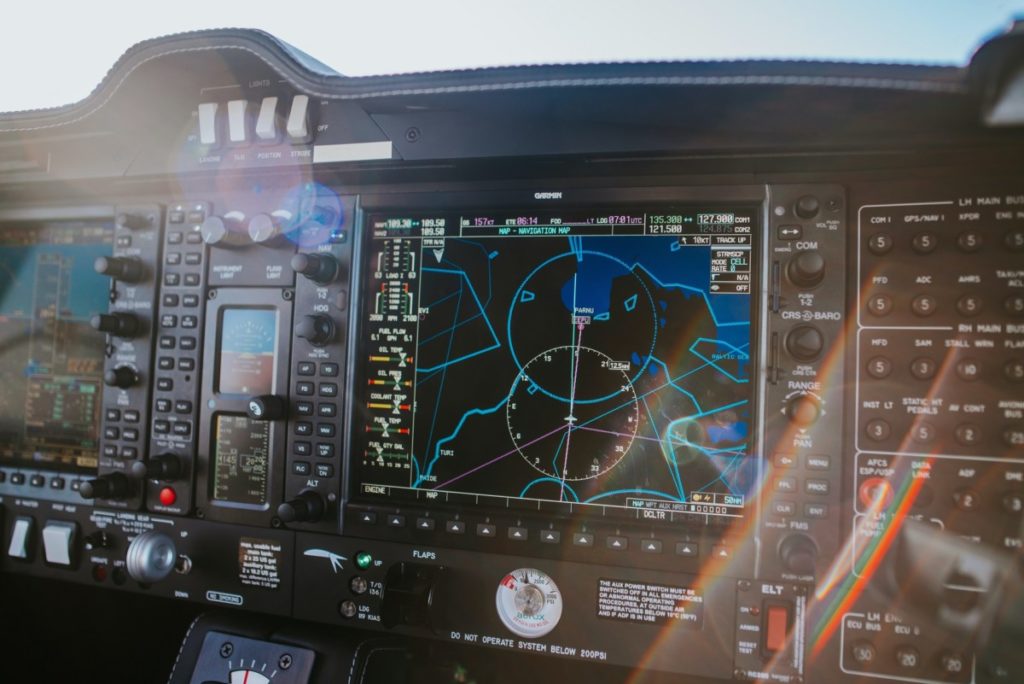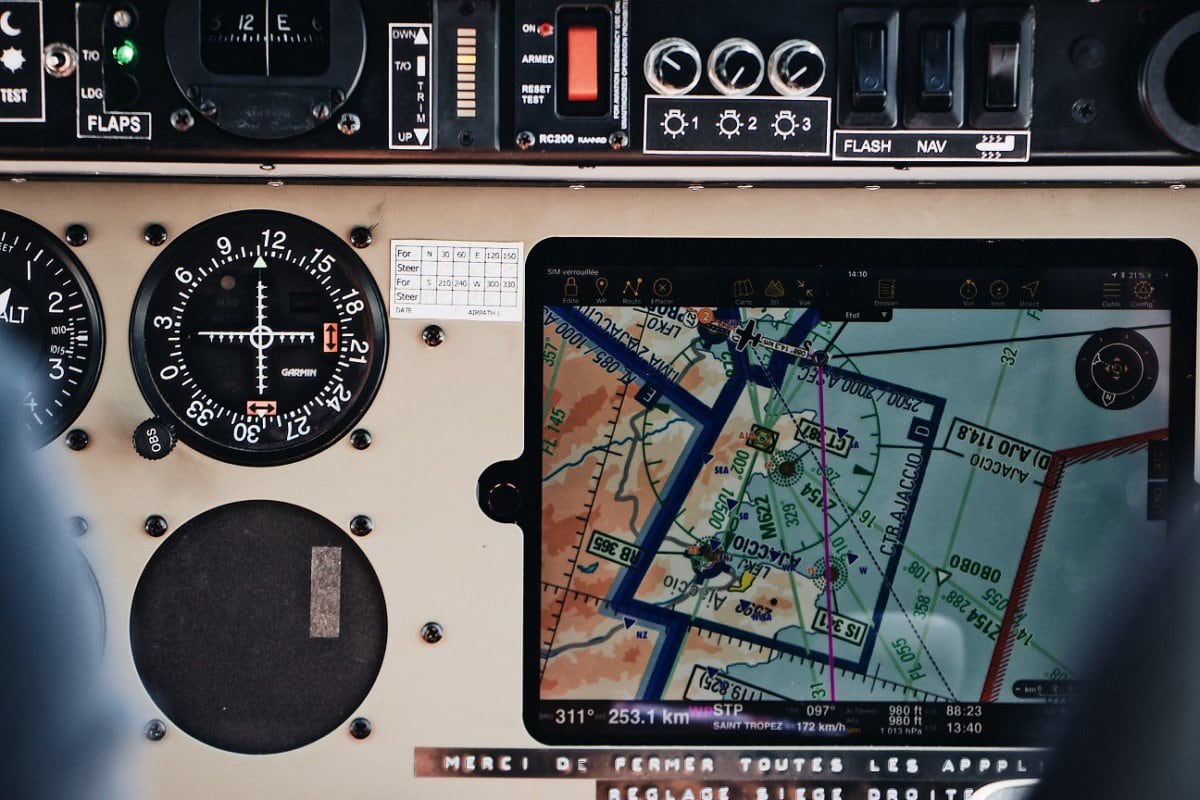As a student pilot, you have made the exciting decision to pursue a passion for aviation. Whether you are learning to fly for personal or professional reasons, the safe and efficient operation of an aircraft requires a comprehensive understanding of navigational aids. Let’s discuss how to utilize these essential tools in your flight training and beyond.
Overview of Navigational Aids
What are navigational aids in aviation?
Navigational aids are devices that help pilots determine their location and navigate their aircraft during flight. There are two main types of navigational aids: ground-based and satellite-based.
Ground-Based Navigational Aids
- VOR (VHF Omnidirectional Range)
- NDB (Non-Directional Beacon)
- DME (Distance Measuring Equipment)
Satellite-Based Navigational Aids
- GPS (Global Positioning System)
- WAAS (Wide Area Augmentation System)
Ground-Based Navigational Aids
VOR (VHF Omnidirectional Range)
A VOR is a ground-based radio station that broadcasts directional information to pilots. This information can be used by the pilot to determine the aircraft’s position relative to the VOR station. The signal from the VOR station contains two components: radial and bearing. The radial component indicates which direction you are flying relative to the station. The bearing component indicates your distance from a specific radial. By using both of these components together, pilots can accurately pinpoint their location in relation to the VOR station.
Do pilots still use VORs?
VORs are still widely used by pilots today. VOR navigational aids are a very important part of flight safety and efficiency. They provide pilots with the ability to accurately determine their position relative to a known navigational aid station. They can also be used for navigating in areas where other navigational aids may not be available.
VOR navigational aids are also easy to use, making them an ideal navigational tool for both novice and experienced pilots. By using the directional information that the station provides, pilots can accurately navigate towards or away from it as needed. This allows pilots to more safely and easily maneuver around obstacles such as mountains or bad weather while still being able to maintain their position relative to the station.
How does a VOR actually work?
A VOR navigational aid station consists of an antenna, a transmitter, and several receivers. It works by transmitting two signals: a reference signal that radiates in all directions from the VOR station and a modulated signal that rotates in a circle around the station.
When an aircraft equipped with a VOR receiver tunes in to the frequency of a VOR station, the receiver compares the phase of the reference signal with the phase of the modulated signal. Based on the difference in the phase of the two signals, the receiver can determine the aircraft’s bearing or radial relative to the VOR station.
The VOR station continually broadcasts the reference and modulated signals, which allows the aircraft to continuously update its bearing information. The VOR system is highly accurate and provides bearing information in degrees, allowing pilots to navigate with precision.
In addition to the VOR signals, the station also transmits an identification signal. This information allows the pilot to confirm that they are tuned to the correct VOR station.
How far away can you pick up a VOR?
The range of a VOR navigational aid station is usually between 40 and 180 nautical miles, depending on the power of the station and other factors. In general, navigational aids with stronger signals can be picked up from further away than those with weaker signals. The strength of the navigational aid signal also depends on geographical features such as mountains, which can interrupt the signal.
How do you navigate with VORs?
Here’s how to use a VOR:
- Tune the VOR receiver in your aircraft to the frequency of the VOR station you want to use. This information can be found on aeronautical charts or obtained from air traffic control.
- Turn the OBS (Omnibearing Selector) dial on the VOR receiver to align the desired radial of the VOR station with the aircraft’s heading indicator.
- Check the TO/FROM indicator on the VOR receiver. If the indicator displays “TO”, it means the aircraft is flying toward the VOR station. “FROM” means the aircraft is flying away from the station.
- Use the VOR signals to navigate. When the aircraft is on the selected radial, the VOR needle will be centered, indicating the aircraft is on course. If the needle moves to the left, it means the aircraft is to the left of the selected radial and needs to steer to the right to get back on course. If the needle moves to the right, it means the aircraft is to the right of the selected radial and needs to steer to the left to get back on course.
- Repeat the process to use additional VOR stations to determine your position and navigate to your destination.
VOR Limitations
It’s important to note that while the VOR system can provide information on an aircraft’s location relative to the ground-based station, it cannot provide altitude information. Other systems such as GPS can provide altitude information.
Even with the advent of GPS navigation, many aircraft are still equipped with VORs due to their reliability and accuracy. In fact, some parts of the world require aircraft operating in remote areas or oceanic routes to rely solely on VOR systems for navigation purposes due to limited or nonexistent GPS coverage in those regions. Some areas require all aircraft operating within their boundaries to be equipped with VOR systems for navigational guidance. For these reasons, VOR navigational systems remain an indispensable part of aviation today.
What is an NDB (Non-Directional Beacon)?
An NDB, or Non-Directional Beacon, is a type of low-frequency radio navigation system used in aviation to determine an aircraft’s position relative to a ground-based station. It works by transmitting a continuous radio signal that radiates in all directions from the NDB station.
How does an NDB work?
An aircraft equipped with an NDB receiver tunes in to the frequency of an NDB station. The receiver picks up the signal and displays the bearing information to the pilot. The pilot then steers the aircraft towards the station, using the display on the receiver to ensure they are on course. When the aircraft is directly over the NDB station, the signal strength is at its maximum. This tells the pilot that they are at the station’s location.
NDBs are used primarily for navigation in VFR (Visual Flight Rules) conditions. This is because they provide only a general indication of an aircraft’s location. In IFR (Instrument Flight Rules) conditions, other navigation systems such as VOR or GPS are used to provide more precise information.
Are non-directional beacons still used?
NDBs have been used since the early 20th century. While they are still used in some areas, they are being phased out in many regions. They are being replaced with other navigation systems that offer improved accuracy and reliability. However, a basic understanding of how they work is still an important part of pilot training.
What is the difference between VORs and NDBs?
The main difference between the two systems is the way they transmit and provide information to the aircraft.
VOR:
- Transmits two signals: a reference signal that radiates in all directions and a modulated signal that rotates in a circle around the station.
- The VOR receiver in the aircraft compares the phase of the two signals. Then, it determines the aircraft’s bearing or radial relative to the VOR station.
- Provides highly accurate and precise bearing information in degrees.
- Used primarily for navigation in IFR (Instrument Flight Rules) conditions, but also used in VFR (Visual Flight Rules) conditions.
NDB:
- Transmits a continuous radio signal that radiates in all directions.
- The NDB receiver in the aircraft measures the signal strength to determine the aircraft’s bearing relative to the NDB station.
- Provides a general indication of an aircraft’s location, but is not as precise as a VOR.
- Used primarily for navigation in VFR conditions, but also used as a backup navigation tool in IFR conditions.
VORs provide more accurate and precise navigation information compared to NDBs. However, NDBs remain a useful backup navigation tool for many pilots, especially in VFR conditions.
What is DME (Distance Measuring Equipment)? How does the DME work?
Distance Measuring Equipment is a navigational aid that measures the slant range distance between an aircraft and ground navigational aids. DMEs use a series of pulses sent out from the navigational aid station to the aircraft and back. It then measures the elapsed time between transmission and reception. It uses this time to calculate the approximate distance away from the navigational aid station. The accuracy of this measurement relies on the navigational aid station’s pulse emission rate being precise and consistent, as well as on the aircraft being able to accurately receive and process these pulses.
DMEs are often used in conjunction with other navigation systems, such as VORs or GPS, to provide more precise information to the pilot. For example, a VOR station may also have a co-located DME station. This allows the pilot to determine both their bearing and range to the station.
DME is becoming less commonly used as GPS and other navigation systems become more prevalent.
Satellite Based Navigation Aids

What is GPS (Global Positioning System)?
GPS (Global Positioning System) is a space-based navigation system developed by the United States government. GPS provides positioning, navigation, and timing services to users around the world. The system uses a network of satellites in orbit around the Earth to determine an individual’s location.
How is GPS used in aviation?
In aviation, GPS is widely used as a primary navigation system. It provides highly accurate and precise information about an aircraft’s position, speed, and altitude. Pilots use GPS receivers to obtain real-time information about their location, course, and altitude. This helps them plan and execute their flights with greater efficiency and safety.
How does GPS work in aviation?
GPS works by using a network of satellites in orbit around the Earth to triangulate an individual’s position. This position can be on the Earth’s surface or in the air. Here’s how it works in more detail:
- Satellites: The GPS system consists of a network of 31 satellites orbiting the Earth at an altitude of 20,200 km. These satellites transmit signals to the ground, containing information about their position and the time the signals were sent.
- Receivers: GPS receivers in aircraft receive these signals from multiple satellites and use this information to calculate the receiver’s position. The receiver determines its position by measuring the time it takes for signals to reach it from multiple satellites. It then uses that information to triangulate its position.
- Position Calculation: The GPS receiver uses trilateration, a mathematical technique that involves measuring the distance from the receiver to at least four satellites. The receiver uses this information to determine its position, as well as its altitude and velocity.
- Navigation: The GPS receiver then uses this information to provide the user with their current position, velocity, and altitude, as well as information about their course and the distance to their destination.
Benefits of GPS In Aviation
GPS has become a crucial tool in aviation. It allows pilots to fly more precise routes, reducing fuel consumption and flight times. It makes it easier to navigate in remote and poorly charted areas. GPS also provides a backup navigation system that can be used in the event of a failure of other navigation systems, such as VOR or NDB.
GPS has revolutionized aviation by providing pilots with a reliable and accurate means of navigation. It plays a vital role in the safe and efficient operation of aircraft and will continue to do so far into the future.
It’s important to note that the accuracy of GPS can be affected by various factors, such as interference from buildings, trees, and other obstructions, and intentional or unintentional jamming or interference with the GPS signals. However, modern GPS systems are designed to minimize these errors and provide highly accurate and reliable navigation information.
WAAS (Wide Area Augmentation System)
The Wide Area Augmentation System (WAAS) is a satellite-based navigation system that provides augmentation to the Global Positioning System to improve its accuracy and reliability. WAAS is used primarily in the aviation industry. However, it can also be used in other applications that require highly accurate navigation information. These applications can include surveying and mapping, marine navigation, and vehicle navigation.
The WAAS system consists of a network of ground-based reference stations located throughout North America, which monitor the GPS signals and compare them to known locations. The reference stations then send this information to a central processing center, where it is used to create a correction signal. This correction signal is then transmitted to a network of geostationary satellites, which rebroadcast it to GPS receivers on the ground.
The GPS receiver then uses the correction signal, along with the GPS signals from the satellites, to calculate a more accurate position. The WAAS system can improve the accuracy of GPS from a few meters to less than one meter, making it highly useful for applications that require precise navigation information.
In aviation, WAAS is used to support instrument landing systems (ILS) and other navigation aids, allowing pilots to make precision approaches to airports even in poor weather conditions. It is also used to support the Federal Aviation Administration’s (FAA) Next Generation Air Transportation System (NextGen), which aims to modernize and improve the efficiency of the US air traffic control system.
Conclusion
Navigational aids are an essential component of modern aviation and play a crucial role in the safe and efficient operation of aircraft. From the traditional VOR and NDB systems to the advanced GPS and WAAS systems, these technologies provide pilots with a reliable means of navigation and help to ensure that they reach their destination safely.
Understanding the different types of navigational aids, their operation, and their limitations is an important part of a student pilot’s education and training. Whether navigating in good weather or adverse conditions, knowing how to use these tools effectively will help to ensure that you have the confidence and skills to fly with greater safety and efficiency.
Recent Posts
Squawk 7700: What Aviation's Emergency Code Means for Pilots
Learn what Squawk 7700 means in aviation, how pilots use this emergency transponder code, and how air traffic control responds to aircraft emergencies worldwide.
Pitot Static System Failures: Causes, Symptoms, and Prevention
Learn about pitot static system failures, how to identify them, and crucial tips for pilots to ensure safety during critical situations.


